Five Dimensional Project Management (Complexity Mapping for Transportation Projects)
Developed by Wiktor Jan Wojciechowski
Five dimensional project management (5DPM) is a framework for handling complexity transportation projects. In addition to the three fundamental sources of complexity 1.Cost, 2.Schedule, 3.Technical the framework recognizes and elevates to the same status two other 4.Context and 5.Financing.
Moreover 5DPM suggests several complex project management tools, one of the most essential being complexity mapping with a radar map used in early stages of project planning.
Contents |
Introduction
Over the past two decades transportation project management (selection, design and construction) has changed considerably. Projects have a larger scope yet shorter delivery periods while external factors like sources of financing and environmental policy dictate the design solutions for most transportation projects. [1] Factors driving the success of projects evolve from a narrow and technical (requirements/design loads) focus into a broader and holistic approach including aspects such as public acceptance, political support, capacity or budget. [2] 5DPM aims to allow the project manager to take on a holistic approach using proactive tools to deliver complex transportation projects. [3]
Complexity
The College of Complex Project Management [4] states that routine projects and complex projects differ by “the degree of disorder, instability, emergence, nonlinearity, recursiveness, uncertainty, irregularity and randomness, including a high uncertainty about objectives”. The US Federal Highway Administration [5] offers a more specific description focusing on projects that “have a high-level of public or congressional interest; are unusually complex; have extraordinary implications for the national transportation system; or are likely to exceed $500 million in total cost.” Both these definitions recognize that complex projects have factors which lie beyond the control of the PM and as such need to be identified, evaluated and recognized in the PM plan. “It is worth noting that neither the CCPM nor the FHWA approach mentions technical factors such as the actual engineering design of the complex project. Therefore, a project can have a complicated technical design without becoming complex.” [3]
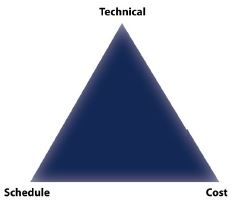
Traditional view
In the traditional approach the three main partners: owner, designer and builder assume their isolated duties. In general the owner (usually a Department of Transportation) secures financing, manages land acquisition (ROW) and handles the communication between shareholders. The designer ensures quality, functionality and compliance with standards. The builder is responsible for managing cost and schedule. The primary responsibilities of the designer and builder form the traditional project management “Iron Triangle” of quality, cost, and schedule. [6]
Five dimensional approach
Apart from the traditional three dimensions complex projects are exposed to high levels of uncertainty and dynamic interactions between the management activities of all project partners. A case study[3] of 18 complex transportation projects in Canada, New Zealand, the United States and the U.K found that these external factors, which have a significant impact on the project, can be grouped in two major categories: project context and project financing. One of this study’s conclusions was that given a five dimensional model of a complex project the PM must manage at least four of the five possible dimensions in order for the project to be considered as complex. Therefore a routine project can be complicated, technically, but if the issues of context and financing have an insignificant magnitude it would not be complex. An example of such a complicated but 'non-complex' project could be a large multilevel interchange in the UAE where nature and surroundings are nothing more than sand and funds are 'unlimited'. Then the PM would only need to focus on the technical aspects and an efficient schedule.
The aim of 5DPM is to allow for a better optimization of resources to ensure the success of a complex project.
Five Dimensions
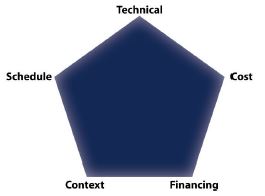
The five dimensions of complexity can be briefly described as follows:
- Technical: all the typical engineering requirements including scope of design and construction, quality, and need for integrated delivery;
- Schedule: the calendar-driven aspects of the project;
- Cost: quantifying the scope of work in monetary terms;
- Context: external influences impacting project development and progress;
- Financing: not cost but the sources of the project’s funding.
5DPM begins by identifying the project’s requirements and constraints and associating each with a given dimension. The goal is to provide the project manager with knowledge of the projects constraints as early as possible so that s/he can reach out to the affected stakeholders for input, support and resources, and by doing so ensure that the final project can satisfy all parties. The division of requirements and constraints in performed using the structure in table: Factors driving complexity in 5DPM.
| Cost | Schedule | Technical | Context | Financing |
|---|---|---|---|---|
|
|
|
|
|
Factors affecting complexity[6]
This section defines the factors driving complexity. For well standardized factors the definition is extended to also contain a list of recommended practices as advised by the Association for the Advancement of Cost Engineering International (AACEI). A proper codification of these factors is essential as it ensures that external stakeholders and project team members understand and use the same terminology. Moreover when each factor is categorized to a single PM dimension it can be further associated with a specific tool for resolution. Lastly a consistent project record makes it a useful reference for future complex project management plans. The following definitions serve as examples and inspiration and by no means cover the full range of possible factors.
Cost
The Cost Dimension of complex project management consists of all factors that must be addressed to quantify the scope of work in monetary terms. According to AACEI[7] the factors defined for this dimension should satisfy the following performance standards:
- Document the overall project scope
- Communicate the estimator’s knowledge of the project by demonstrating an understanding of scope and schedule as it relates to cost
- Alert the project team to potential cost risks and opportunities
- Provide a record of key communications made during estimate preparation
- Provide a record of all documents used to prepare the estimate
- Act as a source of support during dispute resolutions
- Establish the initial baseline for scope, quantities, and cost for use in cost trending throughout the project
- Provide the historical relationships between estimates throughout the project lifecycle
- Facilitate the review and validation of the cost estimate
Project Estimates
Construction estimating is based on understanding what is included and excluded in a given estimation. It’s a fundamental factor and every transportation agency has a policy for making cost estimates. That said most of these policies were developed considering routine projects and may not adequately cover all the requirements of complex projects. Therefore, while these policies set the groundwork for estimation, it is important to ensure that the project estimate satisfies the following criteria:
- Be factually complete, but concise
- Be able to support facts and findings
- Identify estimating team members and their roles
- Describe the tools, techniques, estimating methodology, and data used to develop the cost estimate
- Identify other projects that were referenced or benchmarked during estimate preparation
- Establish the context of the estimate, and support estimate review and validation
- Qualify any rates or factors that are referenced in the estimate (AACEI 2010)
Uncertainty
There is a direct relation between uncertainty and the risk that needs to be distributed in the 5DPM plan. There is a multitude of available tools for managing risk and many agencies use a specific toolset on a routine basis. However, again, these tools may not be sufficient for complex projects. AACEI[8] suggests the following set of performance criteria to guide the analysis and quantification of complex project risks:
Meets project objectives, expectations and requirements
- Facilitates an effective decision or risk management process
- Identifies risk drivers with input from all appropriate parties
- Clearly links risk drivers and cost/schedule outcomes
- Avoids iatrogenic (self-inflicted) risks
- Employs empiricism
- Employs experience/competency
- Provides [the input for the] probabilistic estimating results in a way the supports effective decision making and risk management
Contingency
Contingencies are used to quantify risk in a cost estimate. Common methods for developing contingencies include sensitivity analysis, probabilistic estimating and Monte Carlo simulations.
Project-Related Costs
Project-related costs are those which are necessary to complete the project but may not be financed with the project funding e.g. agency soft costs for personnel or facilities. Project Cost Drivers and Constraints Cost drivers and constraints connect the Cost dimension with the Context and Financing dimensions. An example of these can be a highway project connecting two existing highways. One of the cost drivers will be the requirement to pave the whole distance and there will be little room for adjusting the pavement thickness based on the forecasted traffic. In such a situation it is essential to detail the pavement design as soon as possible as the project relies on that aspect to be fully operational. Should the scope need adjustment to meet the budget the PM will have to search for savings in aspects other than pavement.
Schedule
Schedule includes all calendar-driven aspects of the complex project. Since many complex projects are delivered at a faster pace than routine projects, ensuring a high quality schedule that accurately reflects the relationships between activities is essential to minimizing or eliminating delays.
Time
According to AACEI[9], a comprehensive schedule and its associated basis document contain the following elements:
- Scope of work
- Work breakdown structure
- Key assumptions and constraints
- Execution strategy (sequence of work)
- Key project dates (milestones)
- Critical path
- Path of execution (sequencing of multi-activity work packages rather than individual activities)
- Issues and impacts (risk)
- Inclusions and specific exclusions
- Schedule change order process
- Integration and progress reporting process
- Key procurements and submittals (AACEI 2009)
Schedule Risk
Schedule risk, like cost risk, is handled by establishing contingencies to address each risk to on-time completion. These contingencies can be expressed either in time (e.g. rainy days) or money required to mitigate the risk (additional workforce to recover from a delay).
Prescribed Milestones
Milestones should be connected with the path of execution as they are often used for coordination between stakeholders.
Availability of Resources
Design and construction activities are resource based. Therefore it is important to ensure the availability of the necessary workforce, materials, equipment and financial resources. The project’s resource profile should also differentiate between critical and noncritical resources. (Critical being e.g. scarce equipment like a very large crane which has to be booked months in advance and can be available only for a limited period.)
Technical
Technical dimension includes the engineering requirements, quality of construction, scope of the project as well as the contracting language and possible implementation of new technologies.
Scope of Work
Scope is a broad term but it’s essentially the purpose of the project and defines what needs to be built to fulfil that purpose.
Internal Structure
The internal structure factor focusses on how the agency/owner operates (matrix organisation, traditional hierarchy…) to effectively manage the complex project. This factor also includes decisions about the project team composition. Depending on the delivery method the design, construction, oversight teams can either be closely integrated (e.g. design-build) or work in relative separation (design-bid-build).
Contract
A contract is the main legal documentation between the owner and the projects partners. It includes three factors contributing to complexity i.e.
- prequalification - identifying contractors capable of delivering to requirements.
- warranties - ensuring quality in at least a specified timeframe.
- disputes - should any problems occur this is typically solved contractually.
Design
Different aspects of the design can be presented as factors. These may include reviews and analysis which secure the quality and accuracy of the design or existing conditions referring to the structural limitations which are already in place and need to be considered in the design.
Construction
The trade-offs and limitations that go into the construction factor are defined by:
- Safety - maintaining a healthy and comfortable workplace
- Quality - simply the value of the executed work
- Climate - Naturally climate has to be taken into account in the construction
- Optimization - balance/tradeoff between cost-schedule-quality
Technology
The current pace of technological progress and the fact that intelligent transport systems begin to become common practice demands that technology is included when evaluating complexity.
Nature of Constraints
The projects extremes may be a source of complexity. These can for example include high bridge light to accommodate large transport vessels, extreme topography, crossing areas of high historical or natural significance etc. Recognizing these constraints is a crucial factor for understanding and managing complexity.
Context
Context dimension considers the external factors that can impact the project. These factors can be very difficult to predict before or during the construction.
Stakeholders
Stakeholders are the parties affecting or being affected by the project. The factors include The public which is directly affected by and can potentially affect the project. After all the transportation project is made for public interest. Politicians are typically involved in during financing yet they will surely step in should the project be seen negatively by the public. The owner/agency is the obvious stakeholder. They run and manage the project as well as have most at stake.
Project-Specific
Project-specific factors are directly related to the project and include things like maintaining capacity (e.g. lane closure, detours, time of construction activities) or work zone visualization meaning alerting the public about traffic anomalies due to the construction. It can also consider the necessary cooperation with authorities managing other modes of transportation.
Local issues
Local issues is the broadest category, including several factors for identification while undertaking a transportation project. These factors are:
- Social equity – focused on maintaining equality between all social classes affected or using the project.
- Culture and demographics – focus on how the project is perceived by the public.
- Growth inducement, land use and economy – a potential transportation project can have a significant impact on the region’s economy. On the one hand it can spur growth and alter zoning plans for the region. On the other hand it can affect businesses relying on that mode of transportation by introducing detours or shutdowns during construction.
- Public services can indirectly impose changes to the project by e.g. requiring emergency routes for fire and medical staff.
- Utilities – including all public and private installations that may need to be repositioned (sewers, power, gas, data etc.).
- Land and ROW – being part of the cost dimension these factors need to be considered contextually as well. Intruding an area of high importance/difficulty can drastically affect the complexity of a project. Identifying these areas early can allow implementing evasive adjustment to the alignment.
Environmental
Sustainability and limitations fall under the environmental category. The former considers any requirements for the use of specific materials in construction, the latter defines the scope of necessary environmental studies as well as any site specific environmental factors that may affect the design and construction.
Legal/Legislative
Factors here are the procurement law, defining the availability of alternative delivery methods (Design-Build, Public Private Partnership), and local acceptance, describing the ability and willingness of parties to use these alternative methods should they be unrestricted by the former. Global/National Global and national economics and incidents may increase the complexity of a project.
Unexpected Occurrences
Unexpected Occurrences or unknown unknowns include weather and superior force. Although climate was addressed in the technical dimension in the contextual sense it means unforeseen, abnormal conditions. Superior force can weather induced e.g. catastrophic weather events but may also include effects such as terrorism.
Financing
When considering complex projects it’s no longer enough to simply know the project cost. The owner needs to know how the project is paid for and adjust the scope of work accordingly. To visualize: a small town issues bonds to finance infrastructure improvements. The bond underwriters will not give the owner a blank check, instead they will limit the bonds to an amount that fits with the towns tax base and ability to repay the debt over an acceptable period. The city engineer must then adapt to this situation meaning that the design is no longer driven by technical requirements but by the available funding. It is therefore crucial for the complex project manager to identify the sources and constraints related to financing/debt. However, unlike the four other dimensions which are rather clearly defined, financing is more difficult to specify.
Public Financing
Traditional PM assumes that, given a technical scope, necessary money can simply be obtained from public coffers. In the U.S. public financing for complex projects comes from two sources: state and federal. State is the traditional source, based on taxes and fees, making it fairly flexible. Federal aid on the other hand puts a set of demands on the project and requires an annual project financial plan in order to qualify.
Financing a Future Revenue Stream
A typical example of a revenue stream is a toll road or bridge. In this model the capital cost is financed with a bond which is later repaid using the revenue. This creates three issues.
- The size and expiration of the bond is decided very early, using cost estimates which don’t yet include all the contingencies associated with potential cost growth. This means that the project manager must design to a budget and timeframe imposed not by the technical demands but by the financing.
- Post-construction revenues must be sufficient to cover both the debt as well as operation and maintenance. This must be considered in the design since should an element e.g. pavement fail prematurely it would damage the financial plan.
- Revenues are directly related to the amount of traffic in the future. Therefore financing depends on the traffic estimations and as such may demand increased resources and effort to develop these assumptions.
Exploiting Asset Value
This category is a step forward from a simple revenue based financing. One method is to allow a private entity to take over an existing road for a specific period, derive revenue from it and then return it back to the original state before turning it over to the agency or another private entity. Another method can be franchising. Here private companies would be allowed to build and operate income-producing facilities on the public land in exchange for a portion of the profits. Common examples are rest areas with restaurants and gas stations.
Finance-Driven Project Delivery Methods
Lastly some delivery methods are based on financial considerations. An example being Public-Private Partnerships. Typically these projects are tolling facilities however they differ from a the previous categories by involving both public and private investors in the process. The essence of this category is to gain public access to private capital.
Radar Map (a tool for visualizing complexity)
For better clarity and comparison, impact from factors described above can be showed graphically. One of the tools to do this is a radar map. In essence, during early planning, the project leadership should analyze and evaluate the factors driving complexity in each dimension. The results of this analysis are then scored by dimension in a range of 0-100 (where 0 is minimum complexity and 100 is maximum).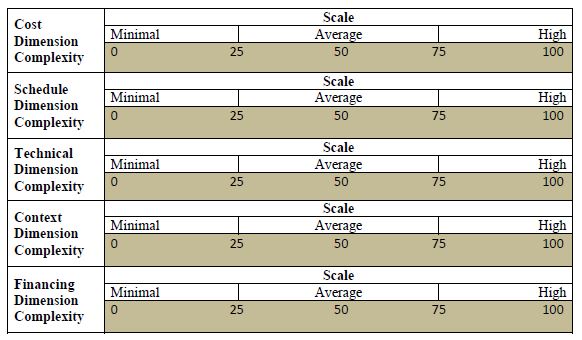
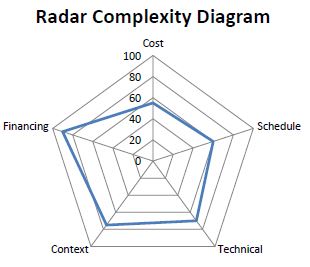
Note that for an individual project it’s important that the team agrees on the relative score for each dimension not the absolute number. However a standardized approach (using surveys, experience) would allow to compare complexity maps across projects.
Moreover it should be remembered that complexity is changing dynamically as the project progresses in time. Therefore as specific factors driving complexity are addressed the complexity map should be revised to realistically depict the current relations.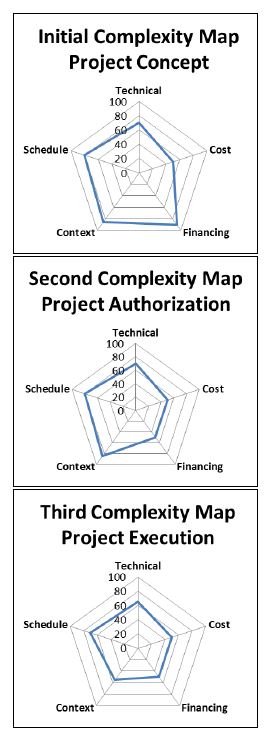
References
- ↑ Federal Highway Administration (FHWA). (2006). Design-build effectiveness study, U.S. Dept. of Transportation, Washington, DC.
- ↑ Jugdev, K., and Muller, R. A. (2005). “Retrospective look at our evolving understanding of project success.” Proj. Manage. J., 36(4), 19–31
- ↑ 3.0 3.1 3.2 Douglas D. Gransberg; Jennifer S. Shane; Kelly Strong; Carla Lopez del Puerto, "Project Complexity Mapping in Five Dimensions for Complex Transportation Projects", Journal of Management Engineering, October 2013, p. 316-326
- ↑ College of Complex Project Managers, and Defence Materiel Organisation (CCPM). (2008). Competency standard for complex project managers, Version 3.3, Commonwealth of Australia, Dept. of Defence, Canberra, Australia.
- ↑ Federal Highway Administration (FHWA). (2010). “Project delivery defined: Major project.” [1](Dec. 4, 2010).
- ↑ 6.0 6.1 6.2 6.3 6.4 6.5 6.6 Douglas D. Gransberg;Jennifer S. Shane; Kelly Strong, (2012), SHRP2 R10, Project Management Strategies for Complex Projects, National Academy of Sciences
- ↑ Association for the Advancement of Cost Engineering International. Recommended Practice 34R-05: Basis of Estimate. AACEI, Morgantown, West Virginia, 2010, p. 5.
- ↑ Association for the Advancement of Cost Engineering International. Recommended Practice 40R-08: Contingency Estimating: Basic Principles. AACEI, Morgantown, West Virginia, 2008, p. 12.
- ↑ Association for the Advancement of Cost Engineering International. Recommended Practice 38R-06: Documenting the Schedule Basis. AACEI, Morgantown, West Virginia, 2009, p. 3.